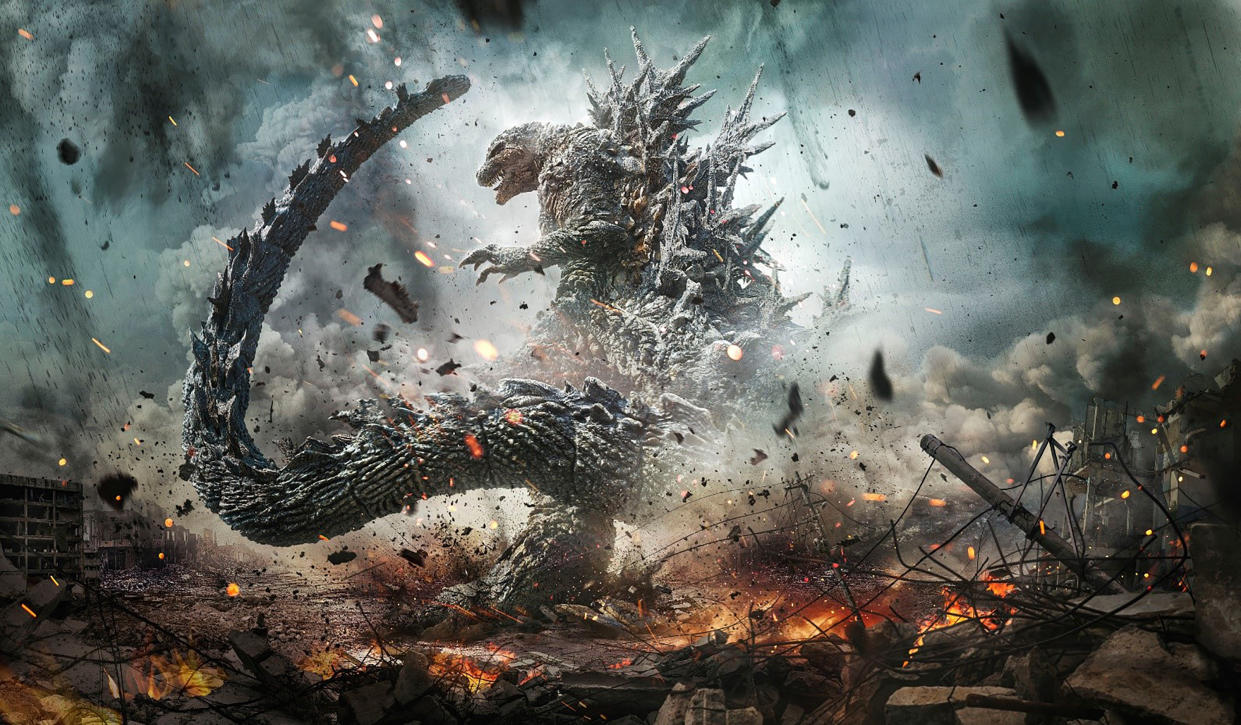Michael Phillips: What does ‘Godzilla Minus One’ have that Hollywood doesn’t?

- Oops!Something went wrong.Please try again later.
- Oops!Something went wrong.Please try again later.
“Godzilla Minus One/Minus Color” plays this week only in theaters, and I’m glad. It’s the remastered black-and-white version of the 2023 color film, the latest in 70 years of Godzilla lore. It’s also one of the peaks.
Per our headline, above: What does “Godzilla Minus One” have that Hollywood doesn’t? Well, broadly: It has the clear, satisfying ability to make something new out of something 70 years old. It’s at once grave and stirring, a very fine monster movie in which you actually care about the human characters.
Also, it was made on a relatively modest budget. Fifteen million dollars is the figure generally ascribed to its production costs, though the film’s writer-director, Takashi Yamazaki — who also co-designed the visual effects, which are visually effective, to say the least — disputed that figure recently, saying: “I wish it were that much.”
Even if $15 million is inaccurately high, it’s still stunningly low in the context of the recent English-language “MonsterVerse” franchise efforts. These include the 2014 “Godzilla” (budget: $160 million; quality, very good), the less popular “Godzilla: King of the Monsters” (2019, budget closer to $200 million) and the pandemic release “Godzilla vs. Kong” (in the same $170-$200 million range to produce). Legendary Entertainment’s latest bid to keep the big guy going, “Godzilla x Kong: The New Empire,” arrives in April.
A lot of those English-language films are fun, even if a sea beast borne of humankind’s atomic death wish makes the fun, you know, hurt a little. But the recent Legendary Studios “Godzillas,” even the best ones, have come at a creative price that, in turn, comes from the price tag. They cost at least 10 times what Toho International’s “Godzilla Minus One” needed to do the job. As a filmmaker, it’s hard to play into your strongest creative instincts when you’re well into nine figures.
In blockbuster context, Yamazaki’s international triumph — it’s the third-biggest non-English language movie to conquer America, after “Life is Beautiful” (No. 2, in more ways than one) and “Crouching Tiger, Hidden Dragon” — represents a triumph of spending what you have wisely and expressively, for spectacle without wearying bombast.
“Godzilla Minus One” works because you actually care about the human characters, and filmmaker Yamazaki’s earnestly handled story of a Japanese World War II kamikaze pilot (Kamiki Ryunosuke), a shame-wracked deserter whose early, shattering encounter with Godzilla leaves him a broken man after the war.
Soon enough, the U.S. devastation of Hiroshima and Nagasaki leaves much of what we see in the late 1945 and postwar scenes in ruins. Then comes another nightmare: Godzilla’s own devastation of Tokyo. The pilot, joining a citizens’ brigade determined to end the carnage, seeks to redeem himself while staying alive for the orphaned girl in his care. The girl’s adoptive mother (Minami Hamabe), a presumptive casualty in Godzilla’s abrupt urban renewal project, leaves the child in a state of ashen emotional peril.
Usually, my guard shoots way, way up with material like this. But here it works, with nary a trace of emotional sadism. The scenes in between the sparing, carefully spaced and gratifying mayhem become more than merely the stuff we endure to get back to the destruction.
The movie has been a huge success in the U.S.; this suggests, I think, that audiences of varying ages will adjust their internal, endlessly distracted moviegoing clocks for a film that doesn’t jump up and down every second to engage. The 2014 English-language “Godzilla,” at its best, worked that way too.
What’s left of the Hollywood studio system has lessons to learn here. The less you spend, the more a movie like this — familiar intellectual property, endlessly rebooted across 70 years — can become something human-made. And if what happens in between rounds of destruction are treated like they matter, they can matter.
Through Feb. 1, the black-and-white edition of “Godzilla Minus One” is yours for the taking, going by the cheeky title “Godzilla Minus One/Minus Color.” A fond visual throwback to the 1954 Toho original, “Minus Color” has been finessed nicely in its monochromatic presentation, though the results rarely look as interesting as a film conceived and lit for black-and-white from the start. Still, I love it; black-and-white remains for many the poetic and expressive of cinematic visions. We’ve seen plenty such projects derived from movies shot in color, including Guillermo Del Toro’s recent “Nightmare Alley.”
It’s a fine way to catch up with “Godzilla Minus One.” The movie’s blend of high melodrama, terrible recent history, shameless but artful contrivance and genuine storytelling persuasion looks easy, just as its $15 million (or whatever it cost) is made to look like $50 million or twice that. And when composer Naoki Sato’s evocative, muted score unleashes the indelible Akiri Ifukuke theme from the ‘54 “Godzilla,” the end credits suddenly become the most compelling end credits imaginable.
———
“Godzilla Minus One/Minus Color” continues in theaters through Feb. 1.
———

